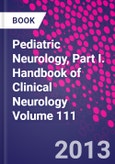The child is neither an adult miniature nor an immature human being: at each age, it expresses specific abilities that optimize adaptation to its environment and development of new acquisitions. Diseases in children cover all specialties encountered in adulthood, and neurology involves a particularly large area, ranging from the brain to the striated muscle, the generation and functioning of which require half the genes of the whole genome and a majority of mitochondrial ones. Human being nervous system is sensitive to prenatal aggression, is particularly immature at birth and development may be affected by a whole range of age-dependent disorders distinct from those that occur in adults. Even diseases more often encountered in adulthood than childhood may have specific expression in the developing nervous system. The course of chronic neurological diseases beginning before adolescence remains distinct from that of adult pathology - not only from the cognitive but also motor perspective, right into adulthood, and a whole area is developing for adult neurologists to care for these children with persisting neurological diseases when they become adults.
Just as pediatric neurology evolved as an identified specialty as the volume and complexity of data became too much for the general pediatician or the adult neurologist to master, the discipline has now continued to evolve into so many subspecialties, such as epilepsy, neuromuscular disease, stroke, malformations, neonatal neurology, metabolic diseases, etc., that the general pediatric neurologist no longer can reasonably possess in-depth expertise in all areas, particularly in dealing with complex cases. Subspecialty expertise thus is provided to some trainees through fellowship programmes following a general pediatric neurology residency and many of these fellowships include training in research.
Since the infectious context, the genetic background and medical practice vary throughout the world, this diversity needs to be represented in a pediatric neurology textbook. Taken together, and although brain malformations (H. Sarnat & P. Curatolo, 2007) and oncology (W. Grisold & R. Soffietti) are covered in detail in other volumes of the same series and therefore only briefly addressed here, these considerations justify the number of volumes, and the number of authors who contributed from all over the world. Experts in the different subspecialties also contributed to design the general framework and contents of the book. Special emphasis is given to the developmental aspect, and normal development is reminded whenever needed - brain, muscle and the immune system. The course of chronic diseases into adulthood and ethical issues specific to the developing nervous system are also addressed.
Please Note: This is an On Demand product, delivery may take up to 11 working days after payment has been received.
Table of Contents
SECTION 1 GENERAL INTRODUCTION; Normal psychomotor development; Clinical neurological examination of infants and children; Pediatric neurology the diagnostic process; Health outcomes measurement: concepts, guidelines and opportunities; Coma; Clinical and imaging diagnosis for heredodegenerative diseases; Developmental aspects of normal EEG; Clinical neurophysiology in movement disorders; Announcing the diagnosis: counselling the parents; Chronic paediatric diseases into adulthood and the challenge of adolescence; Ethical considerations in pediatric neurology; SECTION 2 TOXIC AND DEFICIENCY, FETOPATHIES; Neuroembryology and brain malformations: an overview; Microcephaly; Prenatal-onset neurodevelopmental disorders secondary to toxins, nutritional deficiencies and maternal illness; SECTION 3 CEREBRAL PALSY; Epidemiology of cerebral palsy; Pathophysiology of cerebral palsy; Imaging cerebral palsy; Cerebral palsy: definition, assessment and rehabilitation; Treatment of movement disorders in dystonia-choreoathtosis cerebral palsy; Everyday life and social consequences of cerebral palsy; SECTION 4 DEVELOPMENTAL ABNORMALITIES AND MENTAL RETARDATION; Developmental abnormalities and mental retardation: diagnostic strategy; Specific language impairment; Dyslexia; Congenital Amusia; Developmental dyscalculia; Nonverbal learning disability; Memory disorders in children; Attention deficit; The autistic spectrum; Cognitive and medical features of chromosomal neuploidy; Genetically determined encephalopathy: Rett syndrome; Angelman syndrome; Developmental and cognitive troubles in Williams Syndrome; Smith Magenis syndrome; X-linked mental deficiency; SECTION 5 NEUROECTODERMOSES; Genetics of neural crest and neurocutaneous syndromes; Sturge-Weber syndrome; Tuberous sclerosis; Neurofibromatosis; Incontinentia pigmenti and hypomelanosis of Ito; Epidermal nevus syndrome; Neurocutaneous melanocytosis; SECTION 6 EPILEPSY; The epidemiology of seizure disorders in infancy and childhood: definitions and Classifications; Neuropathology of paediatric epilepsy; The developing cortex; Epileptogenesis in the developing brain; Brain maturation and epilepsy; Modes of onset of epilepsy and differential diagnosis; Varying seizure semiology according to age; Magnetoencephalography (MEG) and other neurophysiological investigations; Neonatal seizures; Febrile and other occasional seizures; Focal epileptogenic lesions; Rasmussen's encephalitis; Immune-mediated paediatric epilepsies; Inborn errors of metabolism and epilepsy; Chromosome disorders associated with epilepsy; Focal malformations of cortical development: a most relevant etiology of epilepsy in Children; Genetics of idiopathic epilepsies; Idiopathic generalized epilepsies; Idiopathic focal epilepsies; Malignant migrating partial seizures in infancy; Infantile spasms; The epileptic encephalopathies; Dravet syndrome (severe myoclonic epilepsy in infancy); Epileptic encephalopathy with continuous spike-waves during slow-wave sleep including Landau-Kleffner syndrome; Lennox-Gastaut syndrome and epilepsy with myoclonic-astatic seizures; Diffuse malformations of cortical development; Myoclonus and epilepsy; Status epilepticus; Cognitive disorders in paediatric epilepsy; Problematic behaviour in children with epilepsy: issues and management; Cognitive side-effects of antiepileptic drugs in children; Initiating antiepileptic drug treatment and characteristics of drugs; Treatment strategies; Developing antiepileptic drugs in children: balancing protection and access; Structural imaging in children with chronic focal epilepsy: exploration strategies and diagnostic algorithms; SPECT (Single photon emission computed tomography) in paediatrics; Functional imaging: PET; Advanced structural and functional MRI in childhood epilepsies; Paediatric epilepsy surgery; Cognitive outcome of surgery; Nonpharmacologic approaches: diet and neurostimulation; Outcome of paediatric epilepsies in adulthood








